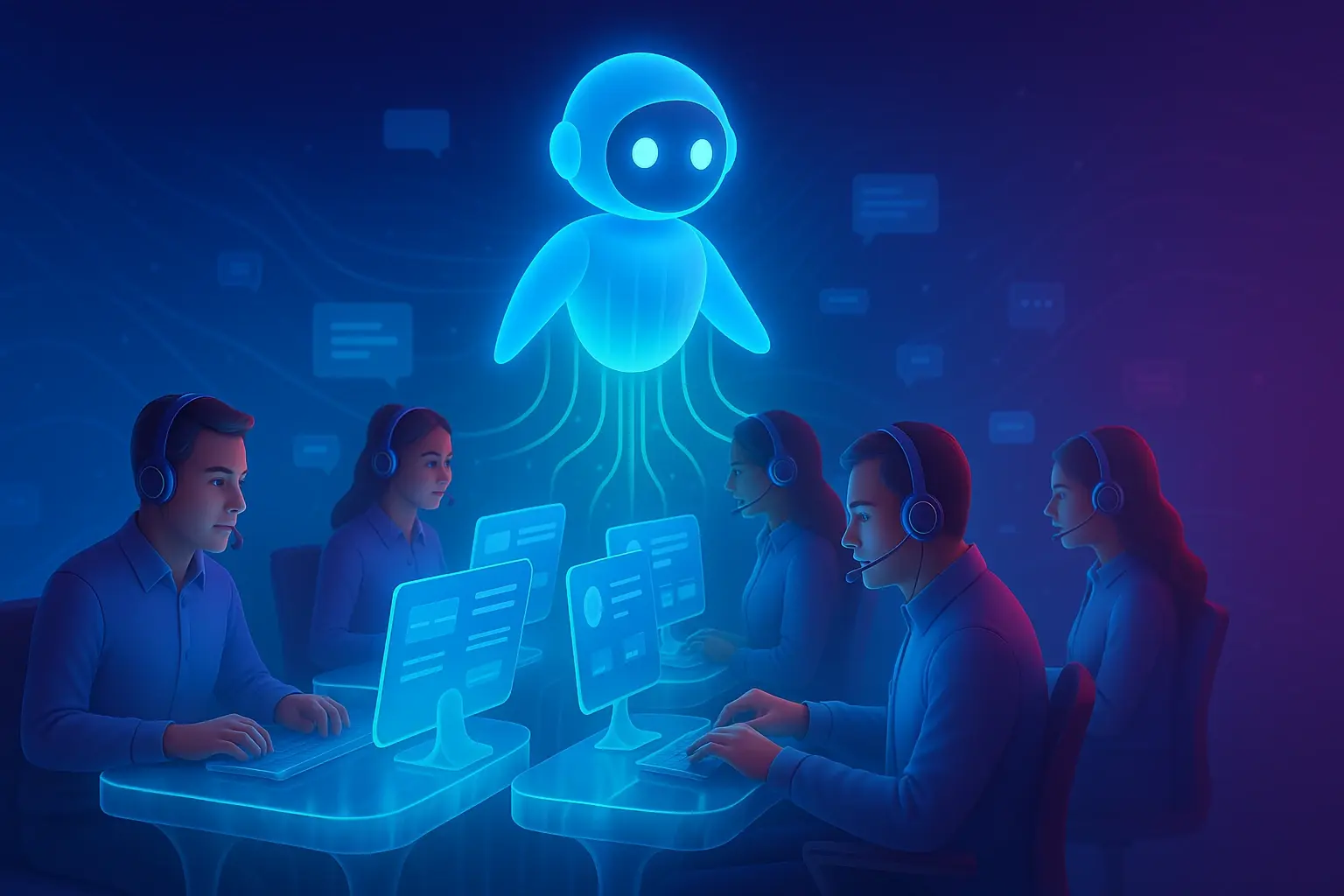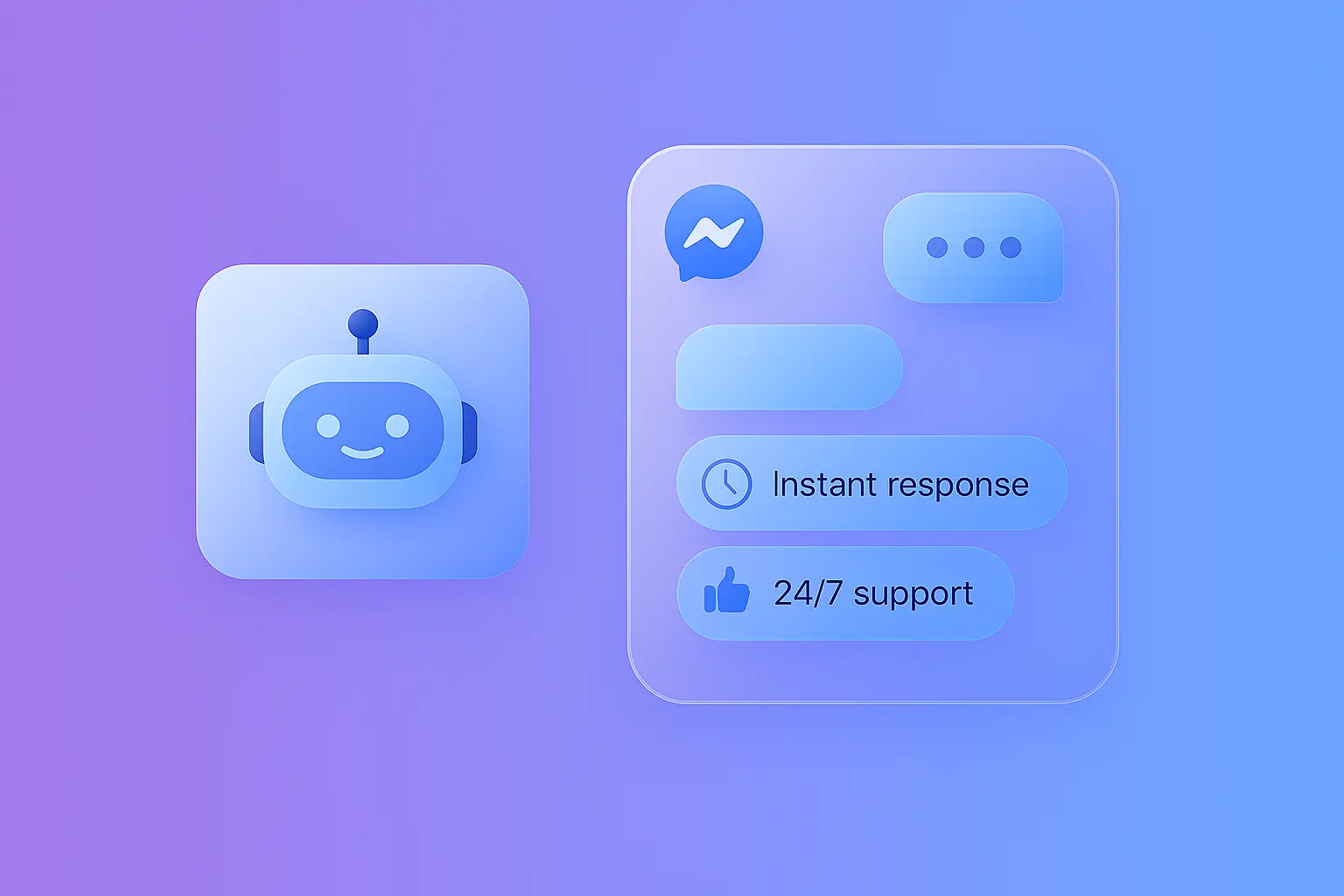What is Conversational AI? How It Works, Use Cases & Examples
- June 3, 2021
- 20 mins read
- Listen

What if you could talk to your technology as naturally as you talk to your friends? With the rapid advancements of conversational AI, you’re just a few lines of code away from making that dream reality. And how it changes the way we interact with technology.
According to recent research, the global conversational AI market is expected to grow at a CAGR of over 21% from 2023 to 2030, reaching a market value of approximately $41.39 billion by 2030. This growth reflects a rising demand for seamless, personalized interactions across industries—from banking to retail and beyond.
This blog explores the fundamentals of conversational AI—its types, components, benefits, and examples. We’ll highlight practical use cases in BFSI, eCommerce, and Telecom, showing how it enhances customer experience, reduces costs, and drives growth. Let’s begin!
What is Conversational AI?
Conversational AI is an advanced technology that enables virtual assistants and chatbots to understand, process, and respond to human language intelligently using Natural Language Processing (NLP), Deep Learning (DL), and Machine Learning (ML).
5 Types of Conversational AI Technology
When it comes to conversational AI, there are different types, each offering unique ways to engage with users. Let’s explore these key technologies and see where each one shines!
1. AI Chatbot / Conversational AI System
- Uses natural language processing (NLP) and machine learning to understand context and respond naturally.
- Continuously improves by learning from interactions, providing increasingly personalized responses.
- By 2025, expected to handle up to 60% of customer service interactions.
- Ideal for companies looking to streamline workflows and manage high volumes efficiently.
2. Rule-Based Chatbot
- Operates on pre-set decision trees or scripts, making it suited for routine inquiries.
- Lacks dynamic learning but is effective for common questions, FAQs, and lead generation.
- Low-cost and easy to implement, often used by smaller businesses or websites with basic support needs.
3. Hybrid Chatbot
- Combines rule-based logic with AI capabilities, offering a balance of simplicity and intelligence.
- Handles basic queries through rules but escalates complex queries to AI or human agents.
- Expected to become standard by 2026 in industries like finance, healthcare, and e-commerce.
- Suitable for companies that need both operational efficiency and customer personalization.
4. Voice Bots / Voice Assistants
- Responds to spoken language, adding convenience and accessibility for users.
- Commonly used in customer service, smart devices, and mobile apps.
- By 2025, projected that nearly 65% of users will engage with voice assistants regularly.
- Valuable in sectors where real-time, hands-free support is essential (e.g., banking, retail, travel).
5. Interactive Voice Assistants (IVA)
- Advanced version of voice bots, leveraging AI, NLP, and voice recognition for a more conversational experience.
- Can understand complex queries, maintain natural conversation flow, and detect emotional cues.
- Expected to see significant growth by 2027, especially in customer service and healthcare.
- Ideal for businesses aiming to deliver personalized, real-time assistance at scale.
Key Components of Conversational Artificial Intelligence
If you’re interested in conversational AI, you’re probably already aware that it’s so much more than just chatbots. In fact, behind every smart interaction you have with conversational AI—whether it’s with a customer service bot or a virtual assistant—there’s a blend of fascinating technologies working together.
Machine Learning (ML)
Machine learning is a field of artificial intelligence that enables computers to learn from data and improve performance over time without being explicitly programmed.
Machine learning is where conversational AI gets its smarts. Think of it as the “brain” that lets AI learn from every interaction. Every time someone talks to an AI, ML algorithms analyze the responses and refine the AI’s ability to react accurately over time.
It’s kind of like how we get better at understanding someone the more we talk with them. ML enables AI to pick up patterns, improve accuracy, and adapt to new phrases and nuances, so it’s always learning and getting better at helping out, whether it’s with customer questions or complex technical issues.
Natural Language Processing (NLP)
Natural language processing (NLP) is a branch of artificial intelligence focused on enabling computers to understand, interpret, and generate human language.
NLP enables conversational AI to understand and interpret human language naturally. It’s the reason AI can engage in real conversations, recognizing sentence structure, context, and even user intent.
But NLP goes further: Can conversational AI handle multiple languages? Yes, absolutely! NLP technology allows conversational AI to operate across various languages and dialects, making it accessible to users worldwide.
Integrations for End-to-End Actions
Integrations enable conversational AI to perform end-to-end actions by connecting with external systems through APIs and other business operations tools. This capability allows conversational AI to autonomously complete tasks—such as retrieving account information, processing orders, or initiating workflows—without requiring manual intervention.
By connecting with databases, customer management systems, and other applications, integrations add depth and functionality to conversational AI, making it a powerful tool for customer service, sales, and operational efficiency.
Advanced Text Analysis
Text analysis is a sophisticated capability within NLP that allows conversational AI to break down sentences into components like subjects, verbs, and objects, and to identify relationships between nouns, adjectives, and other parts of speech.
By understanding sentence structures and context at a deeper level, conversational AI can respond with precision and contextual relevance. This advanced level of text analysis is especially important for applications where nuanced understanding and accurate responses are critical.
Computer Vision for Image Interpretation
Computer vision is an advanced component that enables conversational AI to interpret images, enhancing the AI’s ability to engage in visual contexts. This technology allows AI to identify objects within images, understand their positioning, and even interpret emotions depicted visually.
By processing and analyzing visual data, conversational AI can better respond in scenarios where images are integral to the conversation, such as retail, healthcare, or social media interactions. Computer vision thus broadens conversational AI’s contextual awareness, creating richer and more dynamic interactions.
Benefits of Conversational AI
What conversational AI delivers to customers and businesses? This is the common question that might come into your mind too. Let me give you a glimpse of the benefits of conversational AI.
24/7 Self-service
Conversational AI enables contact centers to offer 24/7 customer support. Customers can get immediate answers to their questions outside of business hours, significantly improving customer satisfaction. This constant availability is crucial in a world where consumers expect immediate and continuous online customer services.
Maximized Engagement
Conversational AI keeps your customers engaged by providing personalized, on-demand interactions that feel almost human. This increased engagement can boost conversion rates by up to 20%, as conversational AI helps capture interest in real-time.
Reduced Agent Handling Time
By managing FAQs and basic tasks, conversational AI frees up agents to focus on more complex issues, cutting average handling times by nearly 30%. This reduces wait times for customers and increases agent productivity, leading to faster resolutions and increase customer happiness.
Propensity Guidance
Conversational AI uses customer data to identify high-value opportunities, guiding users to relevant products or services. This boosts upselling and cross-selling, with companies reporting an average increase of 10-15% in revenue when AI identifies buying signals.
Improved Outcomes
Businesses see a direct impact from conversational AI in terms of customer satisfaction and operational efficiency. As per stats, 69% of customers were satisfied with their last conversation with a chatbot.
Continuous Improvement
Conversational AI models are constantly learning from interactions, becoming smarter and more effective over time. This continuous improvement means that your AI solution will get better at understanding and responding to customer needs, reducing error rates by up to 60% over time.
Hyper-Personalization
Customers value interactions that feel tailored to them. Conversational AI uses insights from past interactions to deliver hyper-personalized responses, improving customer satisfaction by up to 80%, as shown in studies from Accenture.
Live Data Access
With real-time access to customer data, conversational AI can pull relevant information instantly. This makes interactions faster and more accurate, empowering agents with insights that increase first-contact resolution rates by 20-30%.
How Does Conversational AI Function?
Conversational AI is capable of understanding, reacting,ing and learning from every interaction. To achieve the goals, it uses various technologies such as Automatic Speech Recognition (ASR), Natural Language Processing (NLP), Advanced Dialog Management, Predictive Analytics, and Machine Learning (ML).
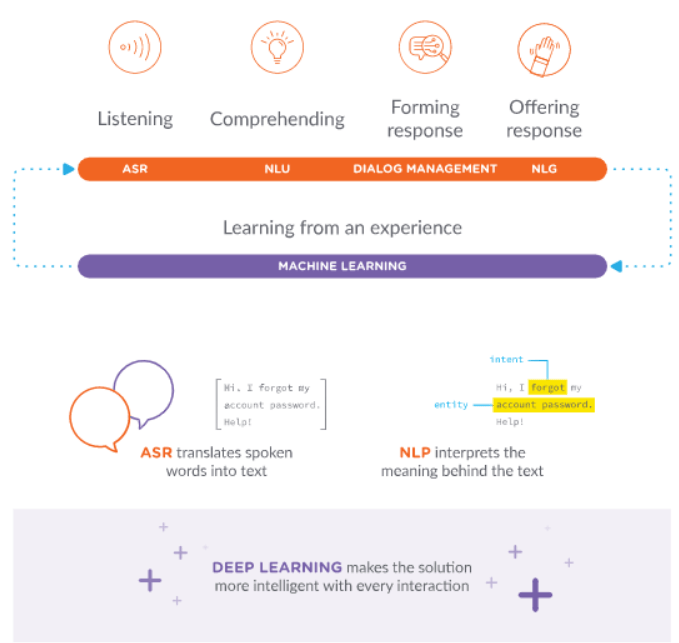
How does conversation AI work?
- It starts working when the AI application receives the information input from the users (either written text or spoken phrases).
- Then the Automated Speech Recognition (ASR) technology helps to listen to the spoken inputs and senses and translates them into a machine-readable format, text.
- Then the AI application has to decipher what the input text means. Natural Language Understanding (NLU) helps to understand the intent behind the text.
- It then forms the response based on its understanding of the text’s intent using Dialog Management.
- The dialog management manages the responses and converts them into a human-understandable format using Natural Language Generation (NLG).
- After that, conversational AI application either delivers the response in text or text to speech.
- Finally, the components are responsible for learning and improving the application over time. It is known as Reinforced learning, where the application learns from the experience to deliver a better response in future interactions.
Conversational AI vs Rule-based Chatbots
The difference between rule-based chatbots and AI-based bots is quite significant.
Rule-based chatbots
Rule-based chatbots also referred to as decision-tree bots, use a series of defined rules. These rules are the basis for the types of problems the chatbot can be familiar with and deliver solutions for. Like a flowchart, rule-based chatbots map out conversations.
Conversational AI bots
AI chatbots combine the power of machine learning and NLP to understand the context and intent of a question before formulating a response. These chatbots generate their own answers to more complicated questions using natural-language responses. The more you use and train these bots, the more they learn and the better they operate with the user.
The below chart enlists the significant difference between conversational bots and rule-based chatbots.
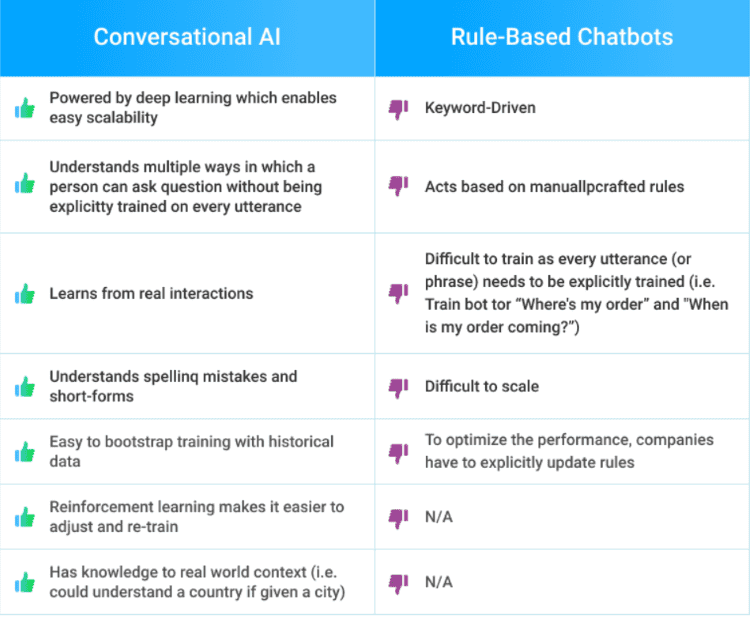
Why does conversational chatbot win?
- The most significant advantage that conversational AI has over rule-based bots is the identification of user contexts and intentions. They can thus decipher a user’s query and deliver a personalized experience.
- The key differentiators of conversational artificial intelligence chatbots are — Natural Language Processing (NLP), Contextual Awareness, Intent Understanding, Integration, Scalability, and Consistency.
Conversational AI Examples and Use Cases Across Industries
Conversational AI is transforming industries by enabling faster, more personalized customer interactions. Let’s look at some industry-specific examples to see how it’s making an impact.
|
Industry |
Use Cases |
| BFSI |
|
| eCommerce |
|
| Telecom |
|
Let’s dive deeper:
BFSI (Banking, Financial Services, and Insurance)
Customer Support Automation: Conversational AI in BFSI handles a high volume of common queries—from account details to transaction histories—cutting down wait times and allowing agents to focus on complex tasks.
Fraud Detection & Prevention: AI-powered chatbots can notify customers of suspicious activity in real-time, minimizing fraud risks and building trust with customers.
Loan Application Assistance: AI assists customers with eligibility checks, documentation, and application processes, making it easier and faster to get loans approved.
For example:

HDFC Bank has a good strategy to leverage conversational AI bot EVA for solving static customer queries related to banking services and increasing revenue.
EVA generates leads by instantly acting upon positive user intent and presenting a service/product that meets their preferences. The conversational banking chatbot solution has resolved over 14.6 Million queries with an accuracy of over 95.5% to date.
eCommerce
Personalized Shopping Assistance: AI chatbots act as virtual shopping assistants, offering personalized product recommendations based on browsing history and preferences, which can boost conversion rates significantly.
Order Tracking & Updates: From order confirmations to real-time shipping updates, chatbots keep customers informed, improving the overall shopping experience and reducing support calls.
Post-Purchase Support: AI assists with returns, exchanges, and post-purchase questions, helping to streamline the process and improve customer satisfaction.
Telecom
Service Troubleshooting: Conversational AI provides quick troubleshooting solutions, from connectivity issues to device settings, often resolving issues without the need for human intervention.
Plan Recommendations: By analyzing customer usage patterns, chatbots recommend optimal plans, helping customers save money while allowing telecom providers to upsell services effectively.
Billing & Payment Support: AI-powered assistants help users understand their bills, set up auto-pay, or pay outstanding balances, providing a convenient, self-service experience.
How to Implement a Conversational AI Strategy?
And now comes the big question… How to successfully integrate conversational AI into a company, regardless of its size? Let’s break down some of the main strategies to implement to do so:
1. Identify the Company’s Goals and Needs
The first step in implementing conversational AI is to clearly define the company’s goals and needs. That is, to determine what problems you want to solve or what aspects you want to improve. A clear understanding of these needs will allow you to identify conversational AI solutions that fit the company’s strategic priorities.
2. Select the Right Technology
There are a variety of conversational AI solutions on the market, from basic chatbots to advanced virtual assistants that can interact naturally with customers. This step is important. You need to select the technology that best fits your company’s needs, considering factors such as automation capabilities, integration with other company systems, and ease of customization. For example: REVE AI-powered chatbot can automate the process, and make seamless integration and customization according to your business needs.
3. Train Employees
Implementing conversational AI is a game-changer for employees, so training is key. They should be provided with training on how to properly use the technology, understand how it interacts with existing processes, and how to monitor and improve its performance.
4. Integrate Conversational AI into Existing Processes
Conversational AI must be seamlessly integrated into all processes to maximize its effectiveness. For example, with customer relationship management (CRM) systems or analytics tools. This will provide a continuous flow of information that improves decision-making and enables greater process automation.
5. Monitor and Improve Performance
Once conversational AI is implemented, you need to monitor its performance regularly to identify areas for improvement and make adjustments to the conversational AI settings, optimizing its performance and ensuring that it remains aligned with the company’s needs.
Top 3 Conversational AI Platforms for Your Business
Here’s a breakdown of the top three conversational AI platforms—REVE Chat, IBM Watson, and Microsoft Bot Framework—to help you find the right fit for your business needs.
| Platform | Key Features | Best For |
| REVE Chat |
| Best for its powerful LLM-based chatbot with AI interactions for small to enterprise businesses. |
| IBM Watson |
| Best for enterprises requiring powerful AI interactions. |
| Microsoft Bot Framework |
| Favored by developers for flexibility and customization within the Microsoft ecosystem. |
1. REVE Chat:
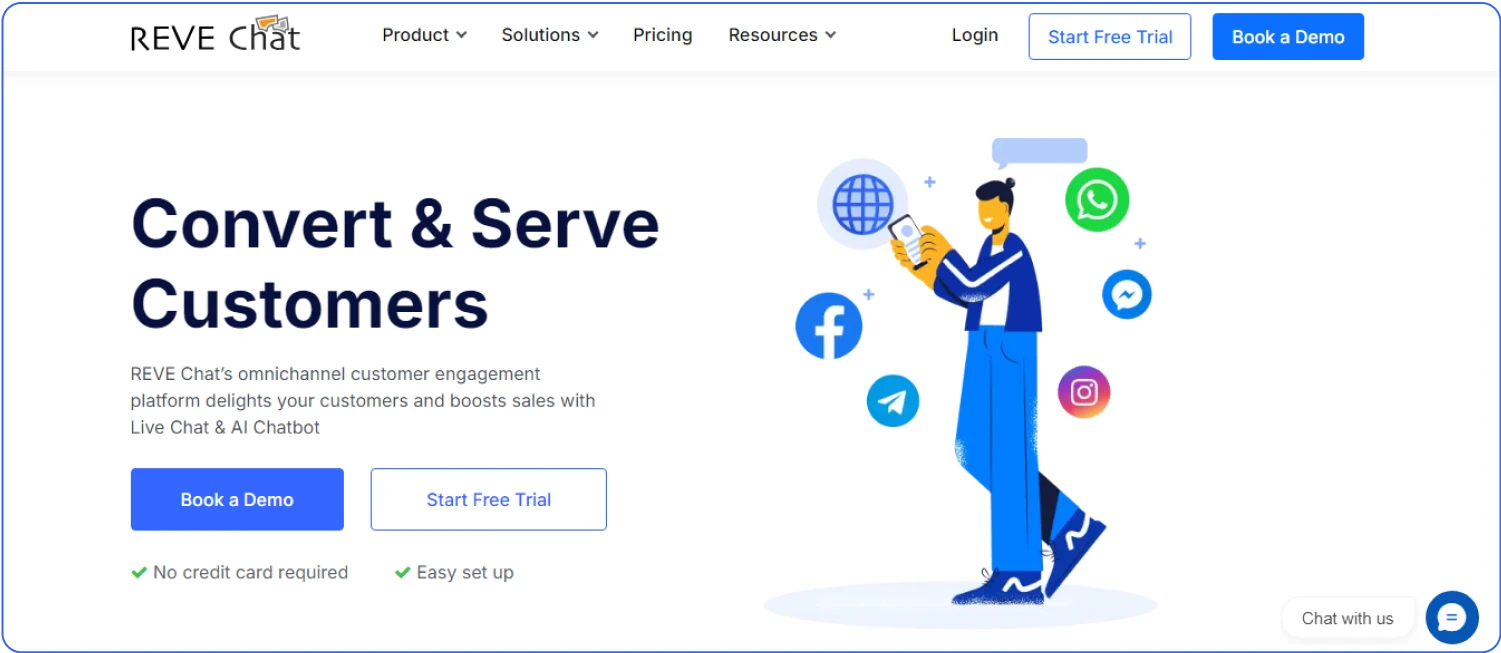
REVE Chat is an AI-driven platform designed for customer engagement, offering IM-enabled live chat and various other features. The platform provides a ready-to-use chatbot platform that allows brands to create customized bots with zero codings based on business needs. Its LLM Chatbot provides a seamless bot that can be trained within a minute and provide an enhanced experience.
Key Features and Capabilities:
LLM-Powered Chatbot: You can leverage the power of Large Language Models (LLM) to enhance your chatbot’s conversational abilities. The LLM adapts quickly, offering more natural, context-aware responses that improve customer interaction and satisfaction.
Visual Flow Builder: You can create your bot flow with the help of nodes and actions such as text, images, carousels, buttons, and others. You can set triggers as per the use case with no coding efforts. Plus, you can give a cute bot name as well.
FAQs: Train your bot regularly by creating FAQs. It allows the bot to identify the user intent and have effective communication with the users.
Human handover: You can set a live chat takeover in case the user asks a complex query that the bot is not able to answer.
Sentiment Analysis: The advanced sentiment analysis feature helps to train the chatbot against offensive and negative expressions. It trains the bot to nullify such responses and focus on the business objectives.
Fallback Option: You can set the fallback options such as alternate phone, email, or connect to the human agents. Identifying the break-up points in the conversation and defining an alternate solution is offered to the bot by the users.
Pros:
Chatbot Builder: REVE Chat provides an intuitive chatbot builder to build the best AI chatbot.
ML Training: Training your chatbots with normalization and bulk machine learning (ML)
Bot to Human Handover: Empowers seamless handover between chatbot and live support to deliver the best conversational experience.
Connectivity: Allows connecting with your Google calendar to book appointments & meetings.
Seamless Integration: Integration is available with WhatsApp, Facebook Messenger, and Viber.
Industry Oriented: Ideal chatbot for telecom, real estate, e-commerce, banking, and most other industries.
2. IBM Watson

IBM Watson offers a comprehensive suite of AI and machine learning services, including the Watsonx Assistant platform for chatbots. Watson Assistant helps businesses create intelligent virtual assistants that engage in natural, human-like conversations. It supports various channels like websites, mobile apps, messaging platforms, and voice assistants. This platform allows organizations to provide personalized customer experiences, automate routine tasks, and offer 24/7 support.
Key Features and Capabilities:
Natural Language Understanding (NLU): Enables the chatbot to understand and respond in natural, everyday language.
Dialog Management: Handles complex conversations, managing multiple topics and providing relevant responses.
Integration Capabilities: Connects to backend systems for tasks like order tracking and account management.
Machine Learning: Continuously improves responses based on user interactions.
Customization: Adjust the bot’s tone, personality, and language to align with your brand.
Analytics: Provides insights into performance, user behavior, and trends for optimization.
Pros:
Powerful AI: Strong NLP, machine learning, and data analysis tools.
Scalability: Handles large data volumes and complex tasks, suitable for enterprises.
Customization: Tailored solutions for business-specific needs.
Industry Focus: Specialized tools and expertise for various industries.
Integration: Easily integrates with existing systems.
Continuous Learning: Improves over time through machine learning.
3. Microsoft Bot Framework
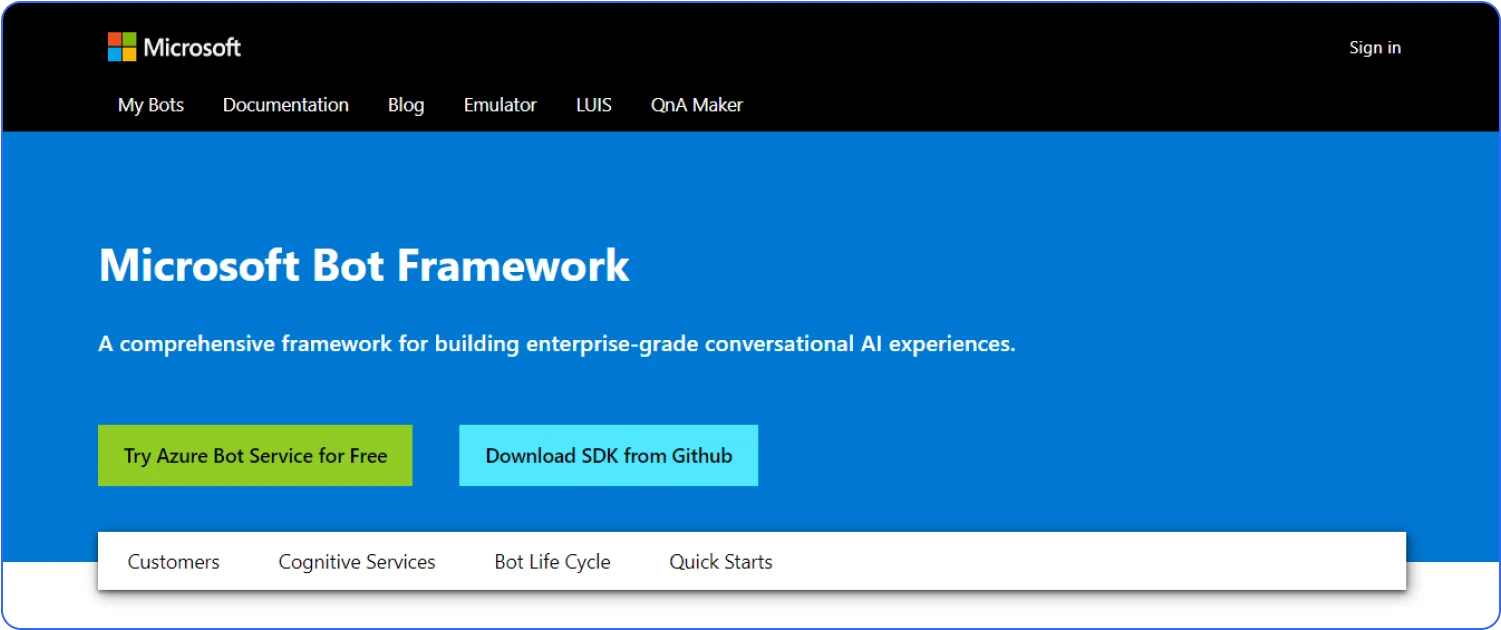
The Microsoft Bot Framework is a powerful platform that enables developers to create, test, deploy, and manage intelligent chatbots. It offers a comprehensive set of tools, SDKs, and services to build bots capable of interacting with users naturally across various channels.
Key Features and Capabilities:
Bot Builder SDK: Supports multiple languages and simplifies bot development.
Azure Bot Service: Provides scalable cloud hosting and management for bots.
Channel Integration: Enables bots to interact across platforms like Teams and Messenger.
Natural Language Processing (NLP): Allows bots to understand and respond naturally to user queries.
Analytics and Insights: Offers tools for tracking and optimizing bot performance.
Customization and Extensibility: Let developers tailor bots to specific brand needs.
Security and Compliance: Ensures bots adhere to security standards and regulatory requirements.
Pros:
Comprehensive Toolset: Provides a wide array of tools for building, testing, deploying, and managing bots.
Strong Integration: Seamlessly connects with Azure Cognitive Services for enhanced AI features.
Channel Flexibility: Supports deployment across various platforms and channels.
Active Community: A large, engaged developer community offers support and resources.
Scalability: Manages increasing user loads and scales as needed.
Open Source: Offers flexibility and customization options.
Challenges of Conversational AI
While conversational AI has made significant advancements in enhancing customer interactions, several challenges still hinder its full potential. Here are some of the primary obstacles:
Understanding Context and Nuances
One of the biggest hurdles is enabling AI to understand the context and subtle nuances in human language. Sarcasm, humor, and idiomatic expressions can often confuse AI, leading to inaccurate responses that disrupt the user experience.
Handling Complex Queries
Although conversational AI is capable of managing many inquiries, complex or multi-part questions can lead to confusion. Ensuring AI can break down and accurately address layered questions remains a challenge, particularly in industries where accuracy is crucial, like finance and healthcare.
Natural Language Processing (NLP) Limitations
Despite advancements in NLP, understanding different languages, dialects, and regional expressions can still be difficult. These limitations can result in inconsistent responses, especially in multilingual environments or where customers use industry-specific jargon.
Training Data Quality
AI performance relies heavily on the quality and diversity of its training data. Inadequate or biased data can lead to skewed responses, impacting the chatbot’s effectiveness and potentially alienating users.
Data Privacy and Security
Conversational AI often handles sensitive data, raising concerns over privacy and security. Ensuring compliance with regulations like GDPR and implementing robust encryption are essential, but they add layers of complexity to AI development.
Continuous Learning and Adaptability
As user behavior and language evolve, conversational AI must adapt to maintain relevance. Continuous learning mechanisms can be challenging to implement, particularly in real-time, which can limit the AI’s responsiveness to new patterns or changing trends.
Balancing Automation and Human Interaction
Finding the right balance between automation and the human touch is critical for conversational AI. Over-automation can lead to user frustration, while excessive reliance on human intervention can reduce the efficiency AI is meant to deliver.
Deployment and Maintenance Costs
Building, deploying, and maintaining sophisticated conversational AI systems require significant investment. For small and medium-sized businesses, the high costs can be prohibitive, making it harder to implement and scale effectively.
Conversational AI Vs. Rule-based Chatbots
The difference between rule-based chatbots and AI-based bots is quite significant.
Rule-based chatbots
Rule-based chatbots also referred to as decision-tree bots, use a series of defined rules. These rules are the basis for the types of problems the chatbot can be familiar with and deliver solutions for. Like a flowchart, rule-based chatbots map out conversations.
Conversational AI bots
AI chatbots combine the power of machine learning and NLP to understand the context and intent of a question before formulating a response. These chatbots generate their own answers to more complicated questions using natural-language responses. The more you use and train these bots, the more they learn and the better they operate with the user.
The below chart enlists the significant difference between conversational bots and rule-based chatbots.
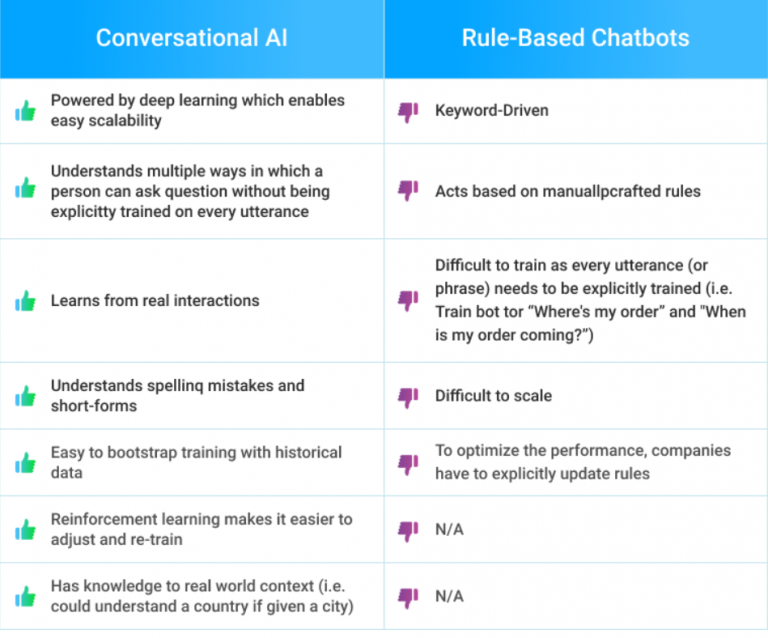
What is the Future of Conversational AI?
The future of conversational AI is incredibly exciting, with new advancements on the horizon that will reshape how we interact with technology. In the next few years, we can expect AI to become even more intelligent, contextual, and human-like, revolutionizing everything from customer service to personal assistance.
With key advancements in emotional intelligence, omnichannel experiences, and personalization, it will be more immersive. AI will better understand emotions, offering more empathetic interactions, while omnichannel AI will provide seamless communication across devices, boosting customer retention by 91% (Forrester). AI avatars will become more common in customer service, with PwC predicting they’ll power 50% of interactions by 2025.
Personalized AI will use deep insights to tailor conversations, with the market projected to reach $13.9 billion by 2029 (MarketsandMarkets). Multilingual capabilities will break language barriers, while AR and VR will create more immersive, interactive AI experiences. Ultimately, conversational AI will enhance human potential, transforming how we work and engage with technology.
Bottom Line
Conversational AI uses NLP and machine learning to power human-like interactions, enabling chatbots and virtual assistants to understand context and respond intelligently. As adoption grows, the future promises even more empathetic and engaging AI experiences.
Book a free demo to discover how REVE Chat’s conversational AI can transform your customer experience!
Know more about: What is AI? Types, Benefits, Use Cases & Examples


